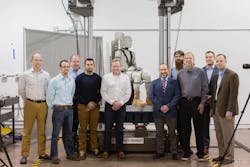A company known for its research on crash and blast effects on soldiers has opened a new test laboratory within its Seal Beach, Calif., headquarters, devoted to improving vehicle designs for enhanced soldier protection. The new WIAMan ATD Lab supports the work of DTS on the design, development, and testing of the blast dummy known as the Warrior Injury Assessment Manikin (WIAMan). The new 3,000 sq.-ft. facility will use the WIAman to study the effects of underbody blasts, from weapons such as improved explosive devices (IEDs), to develop better means of protection and safer military vehicles.
The test facility includes an 11-ft. drop tower used to simulate the vertical impact experienced by an occupant in a vehicle blast. The WIAMan test dummy is secured in a seat in the drop tower while pulses with 200 g’s of force simulate blast impacts. Five different load paths through the pelvis and femur of the crash dummy are measured to quantify potential spine and lower extremity injuries. The drop tower is capable of accelerating a 20-kg impact mass to a velocity of 20 m/s, and high-speed cameras are used to capture motion at 100,000 frames/s.
The WIAMan uses 146 channels of embedded data acquisition and sensors to measure potential skeletal injuries, although it can support as many as 180 channels. The data-acquisition subsystems are distributed throughout the manikin. The data includes six deg. of freedom of forces, moments, accelerations, and angular velocities from sensors located along the pelvis, spine, tibia, and foot/heel of the manikin. The data is analyzed to provide design information for developing safer military vehicles as well as protective tactical gear.
“The program provides a state-of-art test capability to assess potential skeletal injuries of soldiers exposed to under-body blast,” Said Fred Hughes, director of DTS’ WIAMan Engineering Office. “The WIAMan effort is an example of outstanding collaboration among academia, industry, and the government.”


